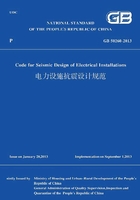
6.3 Seismic Calculation
6.3.1 When static method is adopted,the seismic calculation of electrical facilities shall include the following.
1 Calculation of earthquake action.
2 Calculation of the bending moment and stress induced by the specified combinations of earthquake action and other loads at the root and other critical cross sections of electrical equipment and devices.
3 Calculation of seismic strength.
6.3.2 When mode analysis response spectrum method or time history analysis method is adopted,the seismic calculations for electrical facilities shall include the following.
1 Calculation of the natural frequency and the vibration modes of system.
2 Calculation of earthquake action.
3 Calculation of dynamic responses such as displacement and acceleration of each mass point and bending moment and stress of each cross section.
4 Calculation of the bending moment and stress induced by the specified combinations of earthquake action and other loads at the root and other critical cross sections of electrical equipment and devices.
5 Calculation of seismic strength.
6.3.3 The seismic design of electrical facilities may use the mass-spring system model or the finite element model depending on the system characteristics,calculation accuracy requirements and different calculation methods.
6.3.4 The mass-spring system model shall be created according to the following principles:
1 Single-column,multiple-column and guyed systems may adopt multiple-mass-point cantilever system or mass-spring system.
2 For systems with damping devices for energy dissipation,the shear stiffness,flexural stiffness,and damping ratio shall be taken into consideration.
3 Such long-span electrical devices as high-voltage tubular busbar and large-current enclosed busbar may be simplified to a multi-mass-point spring system.
4 Bushings of transformers may be simplified to a multi-mass-point cantilever system.
5 Calculation shall take into account the flexural stiffness of flange connection of equipment.
6.3.5 To directly build a mass-spring system model,the main mechanical parameters shall be determined according to the following principles:
1 The continuously distributed mass is simplified to several lumped masses and the number of mass points shall be properly determined.
2 The stiffness of cantilever or spring system and the stiffness of connections shall be considered,and it shall comply with the following requirements:
1)The stiffness of cantilever or spring system may be obtained from the elastic modulus and overall dimensions.
2)If the flange and porcelain bushing are cemented,the flexural stiffness Kc may be calculated using the formula below:

Where,Kc——flexural stiffness,N·m/rad;
dc——outer diameter of the cemented part of porcelain bushing,m;
hc——height of cemented porcelain bushing and flange,m;
te——clearance between flange and porcelain bushing,m.
3)If the flange and porcelain are connected through spring clamps,the flexural stiffness may be calculated using the formula below:

Where,h′c——height of the center of spring clamp connection above the bottom of flange,m.
4)The flexural stiffness of damping devices may be determined in accordance with the manufacturer′s performance requirements.
6.3.6 Where a finite element model is created,the type and number of finite elements shall be properly determined and comply with the following requirements:
1 The mechanical parameters of finite element may be directly determined based on the electrical equipment system and the structure of electrical device.
2 Where the flexural stiffness of the connection between porcelain bushing and flange of electrical equipment is substituted by an equivalent beam element,the moment of inertia Ic of the cross section may be calculated using the following formula:

Where,Ic——moment of inertia of cross section,m4;
Lc——length of beam element,m,which is taken as about 1/20 of a single porcelain bushing;
Ec——elastic modulus of porcelain bushing,Pa.
6.3.7 In calculation of the earthquake action of electrical facilities,the actual damping ratio of structure shall be used.If the actual damping ratio of porcelain equipment is unknown,its value is recommended to be up to 2%,and shall comply with the relevant requirements in Chapter 5 of this Code.
6.3.8 Calculation of the structural seismic strength of electrical facilities shall ensure that the stress at the root and other critical cross sections of equipment and device is less than the allowable stress of equipment or materials.
Where the calculation is made with the ultimate strength or the ultimate bending moment,the stress and bending moment of porcelain bushings and insulators shall respectively meet the following formulae.
1 The total stress of porcelain bushings and insulators induced by earthquake action and other loads shall be calculated using the formula below:

Where,σtot——total stress induced by earthquake action and other loads,Pa;
σv——ultimate strength of equipment or materials,Pa.
2 The total bending moment of porcelain bushings and insulators induced by earthquake action and other loads shall be calculated using the formula below:

Where,Mtot——total bending moment induced by earthquake action and other loads,N·m;
Mv——ultimate bending moment of equipment or materials,N·m.